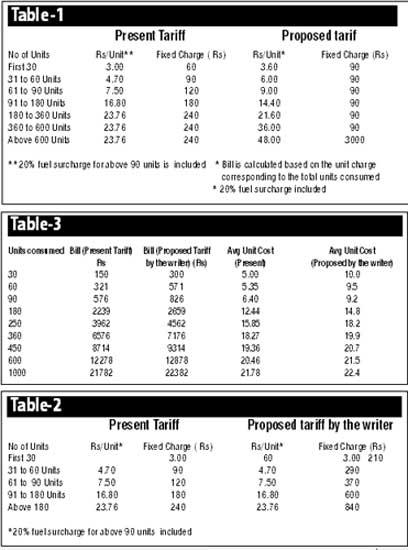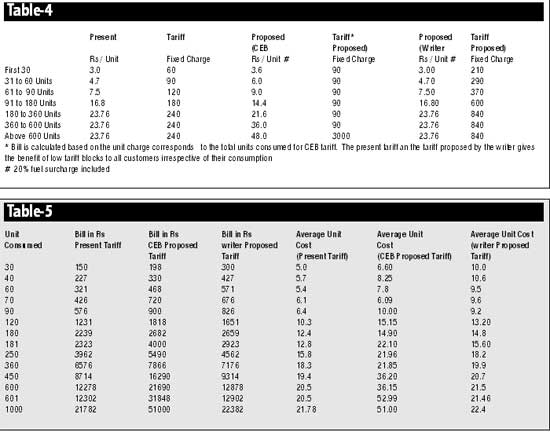
Need for more realistic electricity ratesAs an electricity consumer I believe that the tariff proposed by the CEB is not favourable for a majority of important electricity customers who directly contribute to the economic development of the country. I do agree that electricity tariff has to be increased to meet the costs. At present the government is subsidizing the power sector to the tune of approximately Rs 100 million per day in order to maintain the electricity tariff at the current levels. The state is not in a position to subsidize the sector at this magnitude and therefore a tariff increase is unavoidable.
However when the tariff is revised it has to done very carefully giving adequate emphasis to economic social aspects and the viability of the power sector. I do agree to a certain extent that political aspects too have to be considered in this exercise.However if the tariff is revised considering only political aspects it will be detrimental to the country. Moreover the tariff should be simple so that a layman could understand it easily. To a greater extent tariff should be cost reflective. The cross subsidy given in the current tariff structure cannot be done away with in one go, however in the long run efforts should be taken to minimize the cross subsidy. A monthly variable tariff depending on the world oil prices may not be a reality at present due to other practical problems and therefore a tariff revision per year may be more appropriate in the present scenario. Present and proposed tariff by the CEB Domestic Tariff •In the present tariff fuel surcharge of 20% is imposed only for the customers whose consumption is more than 90 units whereas the proposed tariff impose a fuel surcharge of 20% to all customers. •At present the electricity bill is calculated giving the benefit of lower tariff blocks to all the domestic consumers despite their consumption. However in the proposed tariff this benefit is negated and electricity bill is calculated based on the unit charge corresponding to the total energy consumption. For example if a customer uses 181 units he will be charged for all 181 units at the rate of Rs 21.60. There will be huge jumps in the electricity bill when the total consumption moves from one block to another. New Tariff proposed by the writer Domestic Tariff First 30 Units - Rs 150 Electricity bill should be calculated giving the benefit of low tariff for lower blocks to all consumers irrespective of their total power consumption. The table gives a comparison between the present tariff and the proposed tariff by the writer. Comparison of electricity bill under present and proposed tariff by the writer The above revision will not burden any of the domestic consumer categories since the increase of electricity bill is marginal in rupee terms. The bill of 30 Unit user will be increased by about Rs 150 per month and they will have to bear only Rs 10 per day for electricity. If they use kerosene they have to spend at least Rs 30 per day. I wish to emphasise that the same revenue increase can be expected from the above tariff revision as of the CEB proposed revision which according to my calculations is approximately Rs 11000 million per annum.
Conclusion: The electricity tariff in the country needs an upward revision to reduce the subsidy given by the government to the power sector in Sri Lanka. The average selling price of Unit of energy in Sri Lanka is now Rs 10.50. With the proposed tariff by the CEB an attempt is made to increase the average selling price to Rs 15.50 which is about 50% increase in general. This increase is necessary to reduce the subsidy given to the power sector by Rs 44000 million in the coming year. However when the tariff is revised it has to be done very carefully giving adequate emphasis to economic and social aspects and the viability of the power sector. It appears that the tariff proposed by the CEB has not been derived based on accepted tariff principles. It is rather an arbitrary tariff increase where a Unit charge varies from Rs 6.60 to Rs 53. The writer has proposed a more realistic tariff which will give the same revenue increase of Rs 44000 million. The domestic tariff proposed by the CEB is a kind of a "SARADIEL" tariff where an attempt has been made to rob from high and middle class and to give it to the so-called low income groups who are not actually poor to receive an electricity bill of about Rs 198 per month. A middle class customer who consumes 181 Units will have to pay Rs 22 per Unit whereas a customer who uses only 30 units will have to pay only Rs 6.60 per Unit. The electricity bill of a family who use only 30 Units will only be Rs 198 per month (Rs 6.60 per day) which is not cost reflective at all and subsidized too much. A person who uses Kerosene needs to bear about Rs 700 per month. Moreover customers in this category spend much more on mobile /CDMA phones and other secondary needs. It is true that a cross subsidy is needed to a certain extend to look after low income groups but subsidy incorporated in the CEB proposed tariff is much more than what is actually required. Moreover in the proposed tariff the electricity bill is calculated based on the Unit charge corresponding to the total energy consumption which causes adequate problems to the customer when the total consumption moves from one block to another. This can lead to many malpractices. The Domestic tariff proposed by the writer addresses the above problems and a comparison of the present tariff, CEB proposed tariff and the tariff proposed by the writer is given below. The expected additional income by the CEB from the domestic sector is approximately Rs 11000 million. The tariff proposed by the writer too reaches the same target level while maintaining more cost reflective tariff which may be acceptable to all customer categories. The General Purpose tariff proposed by the CEB is very high and shop owners, other service oriented business owners, government offices will have to pay about 50% to 70% more tariff. Small shop owners are the mostly affected category since the tariff will be increased by 70%. This will affect the food prices and many economic sectors in the country. A much less tariff has been proposed for very big customers which cannot be justified either. The tariff proposed is much more than the cost of production and not cost reflective. The writer has proposed more reasonable tariff for the General Purpose category and details of the same is given below. The additional revenue expected from the tariff proposed by the writer is Rs 7500 million. The present Industrial tariff is not cost reflective by any means and needs an upward revision. I too agree that reasonable concession should be given to the Industrial Sector to promote industries and exporters in the country. I firmly believe that the Industrial tariff should be less than General Purpose Tariff. However the viability of industries does not depend solely on electricity prices but on many other factors such as labour productivity, technology, fuel costs, transport costs etc etc. If this fact is analyzed in detail it will be noticed that the prices of electricity is not the major contributing factor for the viability of industries. The proposed industrial tariff by the CEB is not cost reflective and there is significant difference between IP2 to IP1 and IP3. The Demand charge under the proposed tariff is very high and this may be to encourage power factor correction in industries. However this may not achieve expected results due to many reasons and also could lead to many mal practices. The writer has proposed a more cost reflective tariff for the Industrial sector which is slightly higher than the tariff proposed by the CEB. The details of the same is given below. The new tariff proposed by the writer for the Industrial sector will increase CEB revenue by about Rs 20000 million per year. The Hotel tariff proposed is also arbitrary and it is difficult to understand the logic behind it. After all it cannot be understood why a special tariff is required for the hotel sector all together. In the proposed tariff a small boutique owner will have to pay Rs 24 per Unit while large hotels like five star hotels needs to pay only Rs 12.15 per Unit. This cannot be justified. Giving the Industrial Tariff for large hotels is a discrimination and needs to be done away with. The most appropriate thing is to categorize hotels under General Purpose Category. Two part tariff for Hotel sector does not achieve the expected results and therefore recommended to do away with the Time of Day tariff for the hotel sector. The writer has proposed more realistic tariff for the Hotel sector and the details of the same is given below. This will increase the revenue of CEB by about Rs 700 million per year. The bulk supply tariff to Lanka Electricity Company (LECO) too needs to be revised and the writer proposes an average increase of Rs 5.0 per Unit. This will increase the revenue of CEB by Rs 6000 million approximately. The new tariff proposed by the CEB and the writer, increases the Average Unit cost from Rs 10.50 to Rs 15.50 which will add additional Rs 44000 million rupees for the CEB. It is up to the readers to understand the tariff proposed by the CEB and the tariff proposed by the writer and to make representations to the GM CEB before February 28 before finalizing the electricity tariff in the country. |
|
||||||
|
||||||
| || Front
Page | News
| Editorial
| Columns
| Sports
| Plus
| Financial
Times | International
| Mirror
| TV
Times | Funday Times || |
| |
Reproduction of articles permitted when used without any alterations to contents and the source. |
© Copyright
2008 | Wijeya
Newspapers Ltd.Colombo. Sri Lanka. All Rights Reserved. |

